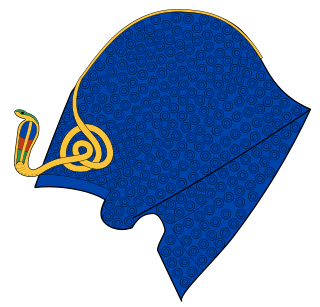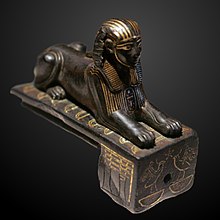
Hapi was the god of the annual flooding of the Nile in ancient Egyptian religion. The flood deposited rich silt on the river's banks, allowing the Egyptians to grow crops. Hapi was greatly celebrated among the Egyptians. Some of the titles of Hapi were "Lord of the Fish and Birds of the Marshes" and "Lord of the River Bringing Vegetation". Hapi is typically depicted as an androgynous figure with a prominent belly and large drooping breasts, wearing a loincloth and ceremonial false beard, depicted in hieroglyphics as an intersex person.
Montu was a falcon-god of war in ancient Egyptian religion, an embodiment of the conquering vitality of the pharaoh. He was particularly worshipped in Upper Egypt and in the district of Thebes.
[Ramesses II] whom victory was foretold as he came from the womb,
Whom valor was given while in the egg,
Bull firm of heart as he treads the arena,
Godly king going forth like Montu on victory day.

Amenhotep III, also known as Amenhotep the Magnificent or Amenhotep the Great, was the ninth pharaoh of the Eighteenth Dynasty. According to different authors, he ruled Egypt from June 1386 to 1349 BC, or from June 1388 BC to December 1351 BC/1350 BC, after his father Thutmose IV died. Amenhotep was Thutmose's son by a minor wife, Mutemwiya.

Thutmose IV was the 8th Pharaoh of the 18th Dynasty of Egypt, who ruled in approximately the 14th century BC. His prenomen or royal name, Menkheperure, means "Established in forms is Re." He was the son of Amenhotep II and Tiaa.

The New Kingdom, also referred to as the Egyptian Empire, is the period in ancient Egyptian history between the sixteenth century BC and the eleventh century BC, covering the Eighteenth, Nineteenth, and Twentieth dynasties of Egypt. Radiocarbon dating places the beginning of the New Kingdom between 1570 BC and 1544 BC. The New Kingdom followed the Second Intermediate Period and was succeeded by the Third Intermediate Period. It was Egypt's most prosperous time and marked the peak of its power.

Deir el-Bahari or Dayr al-Bahri is a complex of mortuary temples and tombs located on the west bank of the Nile, opposite the city of Luxor, Egypt. This is a part of the Theban Necropolis.

The Uraeus, or Ouraeus, (plural: Uraei) is the stylized, upright form of an Egyptian cobra, used as a symbol of sovereignty, royalty, deity and divine authority in ancient Egypt.

Ancient Egyptian art refers to art produced in ancient Egypt between the 6th millennium BC and the 4th century AD, spanning from Prehistoric Egypt until the Christianization of Roman Egypt. It includes paintings, sculptures, drawings on papyrus, faience, jewelry, ivories, architecture, and other art media. It is also very conservative: the art style changed very little over time. Much of the surviving art comes from tombs and monuments, giving more insight into the ancient Egyptian afterlife beliefs.

Spanning over three thousand years, ancient Egypt was not one stable civilization but in constant change and upheaval, commonly split into periods by historians. Likewise, ancient Egyptian architecture is not one style, but a set of styles differing over time but with some commonalities.

The khepresh (ḫprš) was an ancient Egyptian royal headdress. It is also known as the blue crown or war crown. New Kingdom pharaohs are often depicted wearing it in battle, but it was also frequently worn in ceremonies. While it was once called the war crown by many, modern historians refrain from characterizing it thusly.

The Staatliches Museum Ägyptischer Kunst is an archaeological museum in Munich. It contains the Bavarian state collection of ancient Egyptian art and displays exhibits from both the predynastic and dynastic periods. The associated small Middle East section displays objects from the areas of Assyrian and Babylonian culture. For decades, the Egyptian museum was located in the Munich Residenz, but it was moved to the Kunstareal in June 2013.

The ancient Egyptian Man-prisoner is one of the oldest hieroglyphs from Ancient Egypt. An iconographic portrayal from predynastic Egypt eventually led to its incorporation into the writing system of the Egyptian language. Not only rebels from towns or districts, but foreigners from battle were being portrayed.

Ramesses II, commonly known as Ramesses the Great, was an Egyptian pharaoh. He was the third ruler of the Nineteenth Dynasty. Along with Thutmose III of the Eighteenth Dynasty, he is often regarded as the greatest, most celebrated, and most powerful pharaoh of the New Kingdom, which itself was the most powerful period of ancient Egypt.

The Dream Stele, also called the Sphinx Stele, is an epigraphic stele erected between the front paws of the Great Sphinx of Giza by the ancient Egyptian pharaoh Thutmose IV in the first year of the king's reign, 1401 BC, during the 18th Dynasty. As was common with other New Kingdom rulers, the epigraph makes claim to a divine legitimisation of kingship.
The ancient Egyptian Branch hieroglyph, also called a Stick, is a member of the trees and plants hieroglyphs.

The Eighteenth Dynasty of Egypt is classified as the first dynasty of the New Kingdom of Egypt, the era in which ancient Egypt achieved the peak of its power. The Eighteenth Dynasty spanned the period from 1550/1549 to 1292 BC. This dynasty is also known as the Thutmosid Dynasty for the four pharaohs named Thutmose.

Khafre Enthroned is a funerary statue of the Pharaoh Khafre, who reigned during the Fourth Dynasty of ancient Egypt. It is now located in the Egyptian Museum in Cairo. The construction is made of anorthosite gneiss, a valuable, extremely hard, and dark stone brought 400 miles down the Nile River from royal quarries. This highlights Khafre's importance and power as a ruler. The statue was carved for the Pharaoh's valley temple near the Great Sphinx, a part of the necropolis used in funeral rituals. This Old Kingdom statue has an important function in Egyptian tombs as substitute abodes for the Pharaoh's ka—the life force that accompanied a person with a kind of other self. After death, the ka leaves the body into the afterlife, but still needs a place to rest: the statue.
This page list topics related to ancient Egypt.

The Department of Egyptian Antiquities of the Louvre is a department of the Louvre that is responsible for artifacts from the Nile civilizations which date from 4,000 BC to the 4th century. The collection, comprising over 50,000 pieces, is among the world's largest, overviews Egyptian life spanning Ancient Egypt, the Middle Kingdom, the New Kingdom, Coptic art, and the Roman, Ptolemaic, and Byzantine periods.

The Bronze Sphinx of Thutmose III is a statuette of a sphinx made during the 18th Dynasty of Egypt under the reign of Thutmose III, who ruled from c. 1479 to 1425 BCE. Adorned with multiple symbols of royal power, it might have been an element or a lock. It was purchased by the Louvre in 1826, and is part of the permanent collections in the display case 4 in Room 637, Sully Wing, first floor.

![]()






















